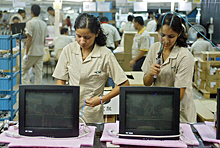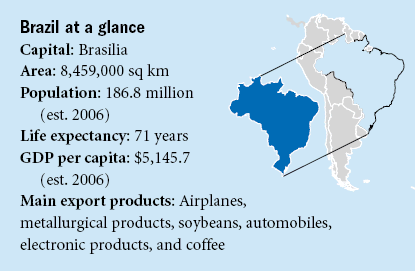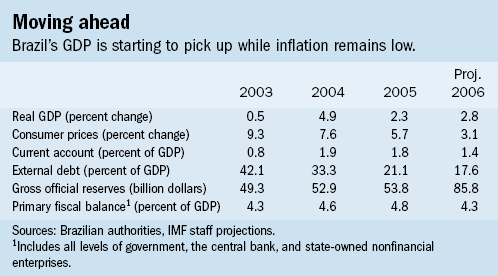
Typical street scene in Santa Ana, El Salvador. (Photo: iStock)
IMF Survey: Brazil Seeks to Unlock Economic Potential
February 26, 2007
- Brazil's economic stability, initiated in mid-1990s, seems well established
- Boosting medium-term growth requires consolidating macroeconomic stability
- Fiscal policy should rely less on higher tax revenue, more on tighter spending
Brazil is building on 10 years of robust economic fundamentals.

Factory in Manaus, Brazil where, IMF says, economic growth has been disappointingly low and country needs to raise productive capacity (photo: Evaristo/AFP)
BUILDING ON ECONOMIC STABILITY
Economic growth, which has long been anemic, is beginning to pick up. Inflation continues to be low. Consumer prices rose only 3 percent between January 2006 and January 2007 and inflation expectations remain low. Brazil's external position is solid, with a strong current account surplus—1½ percent of GDP last year—and international reserves around $95 billion, equivalent to about 170 percent of its short-term debt.
Despite the improvement, economic growth remains low. Real GDP grew less than 3 percent in 2006 and is projected to grow 3.5 percent in 2007—above the annual average of 2½ percent registered since 2000, but below the Latin American average. Brazil recently announced a new program that intends to use increased public investment spending and tax incentives to boost annual growth to 4.5-5 percent.

Even though the focus on raising growth is welcome, unlocking Brazil's vast economic potential—and accelerating the reduction in poverty and income inequality—will require deep structural reforms: this will be the overriding policy challenge for the next few years.
Inflation-fighting program
Brazil has come a long way in the last decade. After a period of high volatility and crises, South America's biggest country reduced inflation drastically by the mid-1990s under the Real Plan; an innovative inflation-fighting program based on an exchange-rate anchor.
Following a period of strong and continued pressure on the exchange rate, the Real Plan gave way to an inflation-targeting framework at the beginning of 1999, with flexible exchange rates and stronger fiscal policy underpinnings. This framework has allowed Brazil to withstand the market turbulence associated with the 2002 elections and the mild market impact of a sequence of corruption scandals in 2005.
The contrasting market reactions to the two episodes point to the improved strength of economic fundamentals in Brazil and the new era of stability in the country, which have been maintained and strengthened by President Luis Inácio Lula da Silva, the candidate initially feared by the markets in 2002.
Low inflation, narrowing income disparities, and reduced poverty are among the many achievements of the last ten years. The 3.1 percent increase in consumer prices last year was well below the middle point of the Central Bank's inflation target range of 4½ percent.
Fiscal Responsibility Law
Income disparities (as measured by Gini coefficients) remain high, but have shrunk to a historic low in 2005 and the percentage of people under the poverty line has fallen to 30 percent, or 13 percentage points below its 1993 peak. Public debt-to-GDP ratios, albeit still high, have also been declining since 2002 as a result of years of fiscal effort and institutional changes, including the innovative Fiscal Responsibility Law of 2000.
At the same time, growth has been disappointingly low. The average rate of growth of 2½ percent since 2000 is well below the 20th century average of about 5 percent. Actually, low growth has been a problem since the early 1980s and the recent performance only underscores the need to go beyond strong macroeconomic fundamentals to raise productive capacity in Brazil
Policies to Raise Growth
The public debate to raise growth has centered on several policy alternatives, most of which are already on the radar screen of the Brazilian authorities. In all likelihood, boosting medium-term growth prospects will require consolidating macroeconomic stability, by solidifying the institutional underpinnings of macroeconomic policies, improving the efficiency of the public sector, and further strengthening the public sector balance sheet.
Continued reliance on inflation targeting with exchange rate flexibility and strong fiscal policies will help keep inflation expectations well anchored. The government has pushed forward administrative reforms of the social security system and plans to further improve its services. Finally, after nearly eliminating the share of bonds linked to the exchange rate, the Treasury plans further reductions in the share of the public debt linked to short-term interest rates, which will reduce vulnerabilities further.

At the same time, it will be important to push ahead an ambitious set of broader structural reforms aimed at improving financial intermediation, encouraging a more open economy, and strengthening the business environment:
• The Brazilian financial system is characterized by a high degree of segmentation, high real interest rates, wide spreads, and low volumes of intermediation. Lowering reserve requirements imposed on commercial banks, reducing financial transactions taxes, and scaling back directed credit (currently about one-third of total credit) would alleviate distortions and contribute to lower market interest rates. Other important reforms to increase the efficiency and competitiveness of credit markets have already taken place, such as reforming bankruptcy laws; improving credit information; and providing employee choice with regard to payroll deposits.
• There has also been increasing consensus that fiscal consolidation policies need to rely less on tax revenue increases and more on tighter expenditure growth. Indeed, Brazil's tax burden is about to reach 40 percent of GDP. In addition, Brazil's budget is very rigid, with a large fraction of revenues earmarked for particular uses, narrowing the scope for more decisive consolidation and reductions in the tax burden. Loosening these rigidities and reducing taxes would lower production and investment costs, and create wider room for private aggregate demand growth.
• Brazil's labor market is characterized by a high degree of informality, stemming in large part from the burden of taxes and regulation on the formal sector. This leads to inefficient small-scale firms, with limited access to financing. Addressing informality directly by reforming the labor code and union organization rules seems to be an important complement to tax reduction.
Prevalence of poverty
Another issue underlying Brazil's weak growth performance is its highly unequal income distribution and the prevalence of poverty. These factors themselves contribute to sluggish growth, both by constraining many households' ability to invest in human capital and to obtain financing to start small firms, as well as by contributing to the fragility of the political equilibrium.
The income distribution in turn reflects a combination of history and various barriers to outsiders' full participation in the economy. Action is already being taken to address poverty through income transfers, including with the highly successful Bolsa Familia program. Public spending priorities are also increasingly directed toward programs that help the poor, including basic education, health care, and water and sanitation.
Brazil faces a moment of historic importance because of the achievements of previous reforms and the unique opportunity to raise the growth profile on a sustainable basis.







